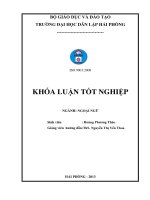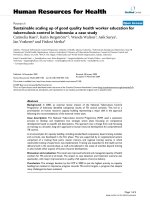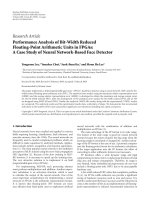The role of good governance practices in enhancing service delivery in public institutions in tanzania the case study of the tanzania electric supply company ltd
Bạn đang xem bản rút gọn của tài liệu. Xem và tải ngay bản đầy đủ của tài liệu tại đây (870.46 KB, 97 trang )
THE ROLE OF GOOD GOVERNANCE PRACTICES IN ENHANCING
SERVICE DELIVERY IN PUBLIC INSTITUTIONS IN TANZANIA: THE
CASE STUDY OF THE TANZANIA ELECTRIC SUPPLY COMPANY LTD
SAADA AHMED ALI
A DISSERTATION SUBMITTED IN PARTIAL FULFILLMENT OF THE
REQUIREMENTS FOR THE DEGREE OF MASTER OF BUSINESS
ADMINISTRATION OF THE OPEN UNIVERSITY OF TANZANIA
2017
ii
CERTIFICATION
The undersigned certifies that he has read and hereby recommends for acceptance by
the Open University of Tanzania a dissertation titled: “The Role of Good
Governance Practices in Enhancing Service Delivery in Public Institutions in
Tanzania: The Case Study of the Tanzania Electric Supply Company Ltd.”, in
partial fulfillment of the requirement for the degree of Master Business
Administration (MBA) of the Open University of Tanzania.
………………………..………………
Dr. William Pallangyo
(Supervisor)
……………………………..……………
Date
iii
COPYRIGHT
No part of this dissertation may be reproduced, stored in any retrieval system, or
transmitted in any form by any means, electronic, mechanical, photocopying,
recording or otherwise without prior written permission of the author or the Open
University of Tanzania on her behalf.
iv
DECLARATION
I, Saada Ahmed Ali, do hereby declare that, this dissertation is my original work
and that; it has not been presented and will not be presented to any other university
for a similar or any other degree award.
………………………..………………
Signature
……………………………..……………
Date
v
DEDICATION
I dedicate this dissertation to my family. This dissertation is the fruit of their sacrifice
and dedication in supporting my studies and career.
vi
ACKNOWLEDGEMENT
My sincere gratitude goes to Almighty God for providing me the strength,
determination and courage I needed to conduct this study. My appreciation also goes
to my adorable family whose moral and material support enabled me to successfully
conduct and complete this study.
My other appreciation goes to my Supervisor, Dr. Pallangyo whose criticism,
intellectual guidance and academic support enabled me to bring this dissertation to
the required level. Dr. Pallangyo fully deserves credit. I also extend my appreciation
to all the academic and support staff at the Open University of Tanzania for their
support.
Last but not least, I would like to extend my gratitude to staff and customers of the
Tanzania Electric Supply Company Ltd (TANESCO) in Kinondoni, Ilala and
Temeke regions as well as those at the Head Quarters for providing me with all the
information I used as data for the present study.
vii
ABSTRACT
This study aimed at finding out the role of good governance practices in enhancing
service delivery in public institutions in Tanzania using The Tanzania Electric
Supply Company Ltd. The main objective of this study was to assess the role of good
governance practices in enhancing service delivery in public institutions in Tanzania.
The methodology used to conduct this study was qualitative research design where
random sampling method was employed to select respondents. Questionnaires were
made use of to gather raw data from the respondents. Secondary data was also used.
The data was analyzed using Microsoft excel package and presented using tables.
The study found that good governance practices are adhered to at TANESCO. It was
also revealed that good governance contribute to quality service delivery at
TANESCO. The study further found that good governance practices at TANESCO
are hindered by various factors such as bureaucracy, corruption and delays. The
study lastly concluded the existence of a relationship between good governance and
service delivery. The study recommended that, to improve service delivery at
TANESCO, the management of TANESCO should ensure that all TANESCO staff
are aware of the principles of good governance and adhere to them in their day to day
activities.
It was suggested, TANESCO, to pay attention to staff and human
resources development strategies with appropriate training packages to enhance
knowledge of good governance.
viii
TABLE OF CONTENTS
CERTIFICATION ..................................................................................................... ii
COPYRIGHT ............................................................................................................ iii
DECLARATION ....................................................................................................... iv
DEDICATION ............................................................................................................ v
ACKNOWLEDGEMENT ........................................................................................ vi
ABSTRACT .............................................................................................................. vii
LIST OF TABLES .................................................................................................. xiii
FIGURE .................................................................................................................... xv
LIST OF APPENDICES ........................................................................................ xvi
LIST OF ABBREVIATIONS ............................................................................... xvii
CHAPTER ONE ........................................................................................................ 1
INTRODUCTION ...................................................................................................... 1
1.1
Background of the Study .................................................................................. 1
1.2
Statement of the Problem ................................................................................. 4
1.3
Objective of the Study ...................................................................................... 5
1.3.1 General Objective of the Study ........................................................................ 5
1.4
Research Questions .......................................................................................... 6
1.4.1 General Research Question .............................................................................. 6
1.4.2 Specific Research Questions ............................................................................ 6
1.5
The Significance of the Study .......................................................................... 6
1.6
Organization of the Research Report ............................................................... 7
ix
CHAPTER TWO ....................................................................................................... 8
LITERATURE REVIEW.......................................................................................... 8
2.1
Introduction ...................................................................................................... 8
2.2
Definition of the Key Terms ............................................................................ 8
2.2.1 Governance....................................................................................................... 8
2.2.2 Good Governance ............................................................................................. 9
2.2.3 Public Institutions and Public Services .......................................................... 10
2.3
Theoretical Literature Review ........................................................................ 10
2.3.1 Intuitive Theory .............................................................................................. 10
2.3.2 SERVQUAL Theory of Customer Satisfaction ............................................. 11
2.4
Empirical Literature Review .......................................................................... 13
2.4.3 Challenges facing Good Governance in Public Institutions........................... 21
2.4.5 Knowledge Gap .............................................................................................. 26
2.5
Conceptual Model .......................................................................................... 26
2.5.1 Description of the Model ................................................................................ 27
CHAPTER THREE ................................................................................................. 29
METHODOLOGY................................................................................................... 29
3.1
Introduction .................................................................................................... 29
3.2
Research Design ............................................................................................. 29
3.3
Research Approach ........................................................................................ 29
3.4
Area of the Study............................................................................................ 30
3.5
Study Population ............................................................................................ 30
3.5.1 Sample Size of the Study ............................................................................... 30
3.5.2 Sampling Technique ....................................................................................... 31
x
3.6
Methods of Data Collection ........................................................................... 32
3.6.1 Primary Data .................................................................................................. 32
3.6.1.1 Questionnaires ................................................................................................ 32
3.6.2 Secondary Data .............................................................................................. 33
3.7
Methods of Data Analysis .............................................................................. 33
3.7
Validity and Reliability of the Research Instrument ...................................... 33
3.7.1 Validity ........................................................................................................... 33
3.7.2 Reliability ....................................................................................................... 34
CHAPTER FOUR .................................................................................................... 35
DATA PRESENTATION AND ANALYSIS ......................................................... 35
4.1
Introduction .................................................................................................... 35
4.2
Profile of the Respondents ............................................................................. 35
4.2.1 Gender of the Respondents ............................................................................ 35
4.2.2 Age of Respondents ....................................................................................... 36
4.2.3 Level of Education of Respondents ............................................................... 37
4.2.4 Experience of Respondents in using TANESCO’s Services ......................... 38
4.3
Knowledge of Good Governance Practices, Perception
and Service Delivery by TANESCO .............................................................. 39
4.3.1 Awareness of Respondents on Good Governance Practices .......................... 39
4.3.2 Knowledge of TANESCO’s Customer Service Charter ................................ 39
4.3.3 he Extent to which TANESCO Abides by the Customer Service Charter ..... 40
4.3.4 The Perception of Respondents on the Quality of TANESCO’s
Services (Only 51 Respondents who were Customers of TANESCO) .......... 41
4.3.5 Experience with Service Delivery Problems with TANESCO ...................... 42
xi
4.3.6 Service Delivery Problems Encountered by Respondents
(51 Respondents who were Customers) ......................................................... 43
4.4
The Extent to which Good Governance Practices are Adhered to at
TANESCO ..................................................................................................... 44
4.4.1 Transparency in Service Delivery at TANESCO ........................................... 44
4.4.2 Accountability in Service Delivery at TANESCO ......................................... 45
4.4.3 Participation in Service Delivery at TANESCO ............................................ 45
4.4.4 Responsiveness in Service Delivery at TANESCO ....................................... 46
4.4.5 Rule of Law in Service Delivery at TANESCO ............................................ 47
4.4.6 Equity in Service Delivery at TANESCO ...................................................... 47
4.4.7 Effectiveness in Service Delivery at TANESCO ........................................... 48
4.4.8 Efficiency in Service Delivery at TANESCO ................................................ 48
4.5
The contribution of Good Governance to Service Delivery at TANESCO ... 49
4.5.1 Good Governance enhances Service Accessibility at TANESCO ................. 49
4.5.2 Good Governance Enhances Service Reliability at TANESCO .................... 50
4.5.3 Good Governance enhancing Service Affordability at TANESCO ............... 50
4.5.4 Good Governance Enhancing Service Responsiveness at TANESCO .......... 51
4.5.5 Good Governance Enhances Service Courtesy at TANESCO ....................... 51
4.5.6 Good Governance Enhances Service Credibility at TANESCO .................... 52
4.5.7 Good Governance Enhances Service Competence at TANESCO ................. 53
4.6
Challenges Hindering Good Governance at TANESCO ............................... 53
4.7
The Relationship between Good Governance and Service Delivery ............. 55
4.8
Findings on TANESCO’s Customer Service Charter Implementation .......... 55
4.8.1 Customer Connection and Metering .............................................................. 55
xii
4.8.2 Power Interruptions ........................................................................................ 57
4.8.3 Customer’s Rights and Obligations ................................................................ 58
4.8.4 TANESCO’s Obligations to Customers ......................................................... 59
4.8.5 Customer Complaints, Enquiries and Requests ............................................. 60
CHAPTER FIVE ...................................................................................................... 62
SUMMARY, CONCLUSION AND RECOMMENDATIONS ............................ 62
5.1
Introduction .................................................................................................... 62
5.2
Summary of Findings ..................................................................................... 62
5.3
Conclusion ...................................................................................................... 65
5.4
Recommendations .......................................................................................... 66
REFERENCES ......................................................................................................... 67
APPENDICES .......................................................................................................... 73
xiii
LIST OF TABLES
Table 4.1: Respondents by Gender ........................................................................... 35
Table 4.2: Age of Respondent .................................................................................. 36
Table 4.3: Level of Education of Respondents ........................................................ 37
Table 4.4: Experience of Respondents in using TANESCO's Services ................... 38
Table 4.5: Awareness of Respondents on Good Governance Practices ................... 39
Table 4.6: Knowledge of the Existence TANESCO's Customer Services Charter .. 40
Table 4.7: The extent to which TANESCO Abides by its Customer Service
Charter ..................................................................................................... 41
Table 4.8: The Perception of Respondents on the Quality of TANESCO’s
Services (51 Respondents who were Customers of TANESCO) ............ 41
Table 4.9: Experience with Service Delivery Problems among Respondents ......... 42
Table 4.10: Service Delivery Problems Encountered by Respondents ...................... 43
Table 4.11:There is Transparency in Service Delivery at TANESCO ...................... 44
Table 4. 12: There is Accountability in Service Delivery at TANESCO .................. 45
Table 4. 13: There is Participation in Service Delivery at TANESCO ...................... 46
Table 4. 14: There is Responsiveness in Service Delivery at TANESCO ................. 46
Table 4. 15:There is Rule of Law in Service Delivery at TANESCO ....................... 47
Table 4.16: There is Equity in Service Delivery at TANESCO ................................ 47
Table 4. 17: There is Effectiveness in Service Delivery at TANESCO..................... 48
Table 4. 18: There is Efficiency in Service Delivery at TANESCO ......................... 49
Table 4.19: Good Governance Enhances Service Accessibility at TANESCO ......... 49
Table 4.20: Good Governance Enhances Service Reliability at TANESCO ............. 50
xiv
Table 4. 21: Good Governance Enhances Service Affordability at TANESCO........ 50
Table 4. 22: Good Governance Enhances Service Responsiveness at TANESCO ... 51
Table 4. 23: Good Governance Enhances Service Courtesy at TANESCO .............. 52
Table 4.24: Good Governance Enhances Service Credibility at TANESCO ............ 52
Table 4.25: Good Governance Enhances Service Competence at TANESCO .......... 53
Table 4.26: Challenges Hindering Good Governance at TANESCO ........................ 54
Table 4.27: Relationship between Good Governance and Service Delivery ............. 55
Table 4.28: Recent Power Tariff Hikes Made by TANESCO ................................... 60
xv
FIGURE
Figure 2.1: Conceptual Framework of the Study ....................................................... 27
xvi
LIST OF APPENDICES
Appendix 1: Questionnaire for TANESCO Customers ............................................ 73
Appendix 2: Questionnaire for TANESCO Staff ..................................................... 77
xvii
LIST OF ABBREVIATIONS
CSV
Comma Separated Values
EWURA
Energy and Water Utilities Regularity Authority
IFA
Institute of Financial Accountants
OECD
Organisation for Economic Co-operation and Development
PSRP
Public Service Reform Program
SERVQUAL Service Quality
TANESCO
Tanzania Electric Supply Company Limited
UN
United Nations
1
CHAPTER ONE
INTRODUCTION
1.1
Background of the Study
Good governance, in this era has drawn public awareness of the operations of public
institutions. It has also become an important factor in the consideration of a nation’s
ability to adhere to universally acceptable democratic standards (Bratton and
Rothchild, 2012). It ensures that political, social and economic priorities are based on
broad consensus in society and that the voices of the poorest and the most vulnerable
are heard in decision-making over the allocation of development resources (World
Bank, 2003).
Good governance in the public sector aims to encourage better service delivery and
improved accountability by establishing a standard for good governance in the public
sector (IFA, 2013). Effective governance in the public sector encourages better
decision making, efficient use of resources and strengthens accountability for the
stewardship of resources (Mutahaba, 2012).
According to IFA (2013), good governance is characterized by strong inspection
which provides important pressures for enhancing public sector performance and
tackling misconduct. It also improves management, leading to more effective
implementation of the chosen interventions, better service delivery and better
outcomes.
The principles of good governance such as participation, rule of law, transparency,
accountability, fairness and efficiency enable employees to be more effective and
2
transparent in providing high quality services. It also protects them from the
tendency towards misconduct (Alaaraj, 2014). On the other hand, weak governance
compromises service delivery and tends to benefit a selected elite.
There is worldwide dissatisfaction with the quality of service offered in public
institutions. Many people complain about the quality of customer service
representatives, facilities, procedure/policies and the general atmosphere of public
institutions. It was reported by Ara and Rahman, (2006) that in Bangladesh poor
quality customer service in the public sector is due to lack of well-organized
management and accountability on the part of public servants.
Rashid (2008) in Malaysia concludes there is poor quality customer service among
employees in government agencies. The Australian Government’s Overseas Aid
Program (2000) reported that in Australia public institutions lacked sufficient
resources and had a leadership that does not adequately involve its stakeholders in
decision making, which lead to customer dissatisfaction with the services provided in
public institutions.
The issue of poor governance in the African public sector has also been well
documented in other studies in the field of public management. Considering the
fragile nature of governance policies in African public institutions, Timothy and
Maitreesh (2005) pointed out that public services delivery in many African countries
is riddled with bureaucracy, corruption, selfishness and favoritism that tend to
benefit the privileged few at the expense of the impoverished many. And this has the
effect of undermining the quality of service offered by these institutions.
3
In Tanzania, public service delivery faces numerous challenges including public
money wastage, low revenue collections, low paid and unmotivated public servants,
poor accountability, and, generally poor performance on service delivery (Issa, 2010
and Magayane, 2013).
On the other hand, the delivery of service by public sector is also not properly
tailored to customer needs. Major setbacks to the efficient running of the public
organization system include lack of employee motivation, poor accountability and
accumulated debts due to unethical and inadequate formulation and implementation
of policies governing these organizations (Lubuva, 2008).
Recent evidence shows that even when resources are allocated for provision of
services, the bulk of it never reaches the intended public (Lubuva, 2008). Despite
broad plans and massive injections of international and domestic resources, public
services delivery is still poor in Tanzania (Lenietal, 2012). This is primarily due to
poor fund management which, in turn, is indicative of poor governance in the
country’s public institutions.
Poor governance in TANESCO is evidently reflected in the rampant multi-million
dollar corruption Tegeta ESCROW scandal in which about TZS 300 billion (US
$250 million) from the revenue collected by TANESCO was illegally distributed
among government officials and other individuals (Guardian Newspaper 2014).
The government of Tanzania has been in the fore front advocating for good
governance by holding seminars and workshops to its public servants in order to
4
improve service delivery to the populace. Despite these, public complaints on
inadequate electricity services, poor electricity infrastructure, poor emergency
response, complex connection procedures, poor customer services, corruption and
frequent power cuts by TANESCO staff are rife (Magayane, 2013). Power supply is
notoriously erratic and there seems to be no guarantee of electricity services in the
country, which in turn will affect the country economic growth and community
development.
1.2
Statement of the Problem
Since establishment of TANESCO in the year 1967, only 18.4% of the country’s
citizens have access to electricity (TANESCO Annual Report, 2014). Low access
and utilization of electricity in the country for decades is a matter of concern which
stagnate country development and TANESCO growth as an institution. There is
worldwide dissatisfaction with the quality of service offered in public institutions. In
Africa particularly Tanzania, many people complain about the quality of customer
service representatives, facilities, procedure/policies and the general atmosphere of
public institutions.
In addition, the delivery of service by public sector is also not properly tailored to
customer needs. Therefore, public service delivery faces numerous challenges
including public money wastage, low revenue collections, low paid and unmotivated
public servants, poor accountability and generally poor performance on service
delivery (Issa, 2010 and Magayane, 2013).
According to Tanzania utilities performance report for the year 2008/2009 poor
electricity services were attributed to poor institutional governance. Moreover, there
5
are public cries on inadequate electricity services, poor electricity infrastructure, poor
emergency response, complex connection procedures, poor customer services,
corruption and frequent power cuts by TANESCO staff are rife (Magayane, 2013).
This raised the question “Does good governance enhance service delivery?” and
prompted a study to investigate the role of good governance in enhancing the
delivery of service in public institutions in Tanzania
1.3
Objective of the Study
The objectives of the study were divided in to two categories namely, general and
specific objectives.
1.3.1
General Objective of the Study
The main objective of the study was to assess the role of good governance practices
in enhancing service delivery in public institutions in Tanzania.
1.3.2 Specific Objective of the Study
The specific objectives of the study were:
(i)
To examine the extent of adherence to good governance practices in public
institutions.
(ii)
To determine the contribution of good governance to service delivery in public
institutions.
(iii) To analyze challenges facing good governance in public institutions.
(iv) To determine the relationship between good governance and service delivery in
public institutions.
6
1.4
Research Questions
The study was guided by the following research questions;
1.4.1
General Research Question
The main question of the proposed study was: What are the roles of good governance
in enhancing service delivery in public institution.
1.4.2
Specific Research Questions
The specific research questions of the study were:
(i)
What is the extent that public institutions adhere to good governance practices?
(ii)
Does good governance have any contribution to the quality of public service
delivery in public institutions?
(iii) What are the challenges facing good governance in public institutions?
(iv) What is the relationship between good governance and service delivery in
public institutions?
1.5
The Significance of the Study
The study will benefit policy makers and committees responsible for ensuring
quality service delivery in public institutions and help them come up with highly
modified policies as well as more appropriate measures to improve governance in
public institutions, enabling them to attain high levels of service quality. It will be of
great importance to the institution under study since it will make the management
aware of their position in terms of good governance and help them know how best to
govern the institution. Furthermore the study will serve as a source of information
and reference to future researchers.
7
1.6
Organization of the Research Report
The research report is organized in five chapters; chapter one: Describes the
background of the study, statement of problem, research objectives and questions,
the significance of the study and organization of the report. Chapter two: Identifies
key terms and relevant theories that were used in the study as a guide to better
understanding of the role of good governance practices in the enhancement of public
service delivery. It also presents relevant literature that was reviewed and used as
conceptual model.
Chapter three: Presents the methodology of the study. It is centered on research
design, area, population, sample size, sampling technique, data collection, methods
of data analysis, validity and reliability of research instrument. Chapter four: Is
devoted to the presentation of data and an analysis of results and findings.
Chapter five: Presents the Summary, conclusion, implications of the study,
recommendation and suggestions for further research.
8
CHAPTER TWO
LITERATURE REVIEW
2.1
Introduction
This chapter presents the definitions of key terms, a theoretical literature review, an
empirical literature review, the literature gaps and the conceptual framework. The
reviews of literature led to draw significant conclusion and served as a guide for the
study.
2.2
Definition of the Key Terms
A theoretical definition gives the meaning of a word in terms of the theories of a
specific discipline. This type of definition assumes both knowledge and acceptance
of the theories that the study depends on. According to Patrick (2007), theoretical
definitions are common in scientific contexts, where theories tend to be more
precisely defined and results more widely accepted as correct.
2.2.1
Governance
Governance refers to the formal and informal arrangements that determine how
public decisions are made and how public actions are carried out from the
perspective of maintaining a country’s constitutional values (United Nations, 2007).
Governance has been defined as a network of private non- governmental bodies that
have a role to play in the formulation and implementation of public policy and the
delivery of public services. Governance is government plus the private and third (not
for profit) sectors (Smith, 2007).









